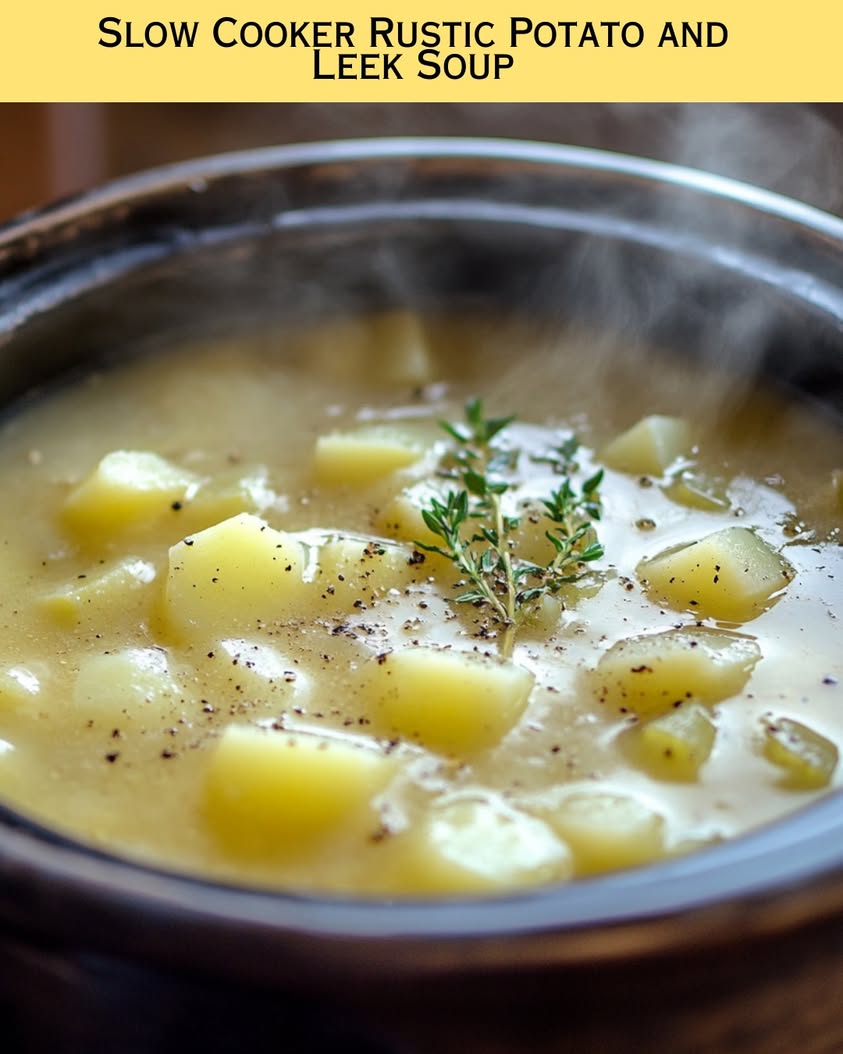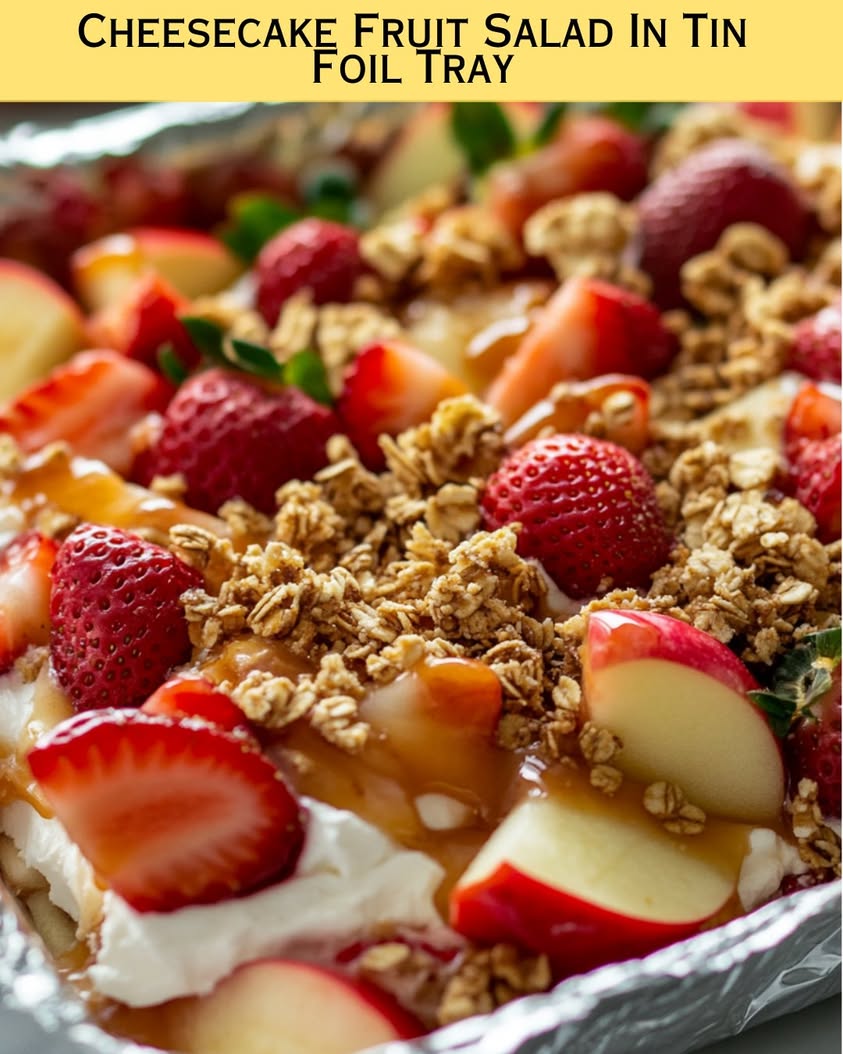Slow Cooker Rustic Potato and Leek Soup: A Hearty Comfort in a Bowl
This Slow Cooker Rustic Potato and Leek Soup is the perfect remedy for a chilly day or a cozy night in. Featuring a blend of earthy potatoes and subtle leeks, this creamy soup brings warmth and comfort with every spoonful. The beauty of this recipe lies not only in its rich flavors but also in its simplicity; simply toss the ingredients into the slow cooker, and let it work its magic. The end result is a comforting bowl of velvety soup that’s perfect for any occasion.
As you take your first bite, the flavor profile unfolds like a well-kept secret, revealing the delightful taste of leeks paired with the creamy texture of potatoes. The harmony of these ingredients brings to life a dish that feels both rustic and sophisticated. This Slow Cooker Rustic Potato and Leek Soup not only nourishes the body but also warms the heart, making it an ideal solution for family gatherings or a quiet dinner alone.
Quick Recipe Highlights
- Flavor Profile: The soup offers a rich combination of sweet leeks and earthy potatoes, punctuated with hints of garlic and herbs that deepen the overall taste.
- Texture: Creamy yet hearty, the soup is smooth with chunks of tender potato that provide satisfying bites.
- Aroma: The aroma of warm leeks gently sautéing fills the air, creating a welcoming atmosphere in your kitchen.
- Visual Appeal: With a soft, inviting color palette of creamy white and pale green, the soup is garnished beautifully for a comforting presentation.
- Skill Level Needed: This recipe is straightforward and approachable for cooks of all levels, requiring basic knife skills and an understanding of slow cooking.
- Special Equipment: A slow cooker is essential for this recipe, allowing flavors to meld together slowly for maximum taste.
Recipe Overview
- Difficulty Level: Simple enough for beginners, this soup requires minimal hands-on time and is nearly foolproof, making it a great choice for anyone looking to build confidence in the kitchen.
- Category: Enjoy this dish as a main course or a side, perfect for lunch or dinner.
- Cuisine: This soup draws inspiration from rustic European culinary traditions, where hearty and warming dishes are celebrated.
- Cost: Utilizing inexpensive, readily available ingredients, this recipe provides a heartwarming meal without breaking the bank.
- Season: Perfect for fall and winter months, this soup provides a warming comfort that aligns beautifully with the changing seasons.
- Occasion: Ideal for family meals, holiday gatherings, or a comforting weeknight dinner, this soup is versatile enough for any occasion.
Why You’ll Love This Recipe
The taste and texture of this Slow Cooker Rustic Potato and Leek Soup are simply irresistible. Each spoonful encapsulates the earthiness of potatoes complemented by the sweetness of leeks, providing a delicate balance of flavors that feels nourishing. The creaminess makes it a satisfying dish that you can savor, especially when served with crusty bread for dipping.
Convenience is another standout feature of this recipe. By using a slow cooker, you can prepare the ingredients in the morning and walk away. Just set it up and enjoy the alluring aroma that fills your home while it cooks. It’s a great way to create a home-cooked meal without spending hours in the kitchen.
From a nutritional perspective, this soup packs a punch with essential vitamins and minerals. Potatoes are rich in potassium and vitamin C, while leeks offer antioxidants and support digestive health. Combined, they make for a soup that nourishes the body as much as the spirit.
Entertaining guests? This recipe shines at social gatherings. It’s a dish that sparks conversation, and serves as a great starter for a dinner party, leaving everyone feeling satisfied yet curious about the recipe. Plus, it’s easy to scale up for larger gatherings.
Cost-effective and accessible, the ingredients for this soup are often found in most pantries and can easily fit into any grocery budget. This makes it a practical choice for families or anyone looking to create a hearty meal without expense.
Historical Background and Cultural Significance
The origins of potato and leek soup can be traced back to regions in Europe, particularly Wales and France, where it is cherished as a farm-fresh staple. Historically, these ingredients were easily grown and harvested, allowing the dish to become a beloved part of the local culture.
In Welsh cuisine, the combination of potatoes and leeks is so significant that there is even a day dedicated to the leek, showcasing its importance in traditional recipes. This soup serves as a reminder of community and sustenance, bringing people together around the table.
Over the years, the recipe has evolved from its rustic roots into a dish that showcases seasonal ingredients and modern culinary techniques. Each chef adds their own twist, allowing for variations that reflect regional tastes and preferences.
Regional variations can be found across different cultures. In France, a creamier version known as “Vichyssoise” incorporates leeks and potatoes while focusing on a smooth texture, often served chilled. This highlights the versatility and enduring appeal of the ingredients.
Ingredient Deep Dive
Potatoes: Potatoes have been a staple in many diets since their introduction to Europe from South America. They are versatile, nutrient-rich, and store well, making them an essential ingredient worldwide. When selecting potatoes, look for firm ones with smooth skin; avoid any that are sprouting or have blemishes. Potatoes should be stored in a cool, dark place and can be used in countless recipes beyond soups.
Leeks: Leeks hold a rich history in the culinary world, especially in Mediterranean cuisine. They are loaded with vitamins A, C, and K, and are known for their unique sweet flavor profile. Choose leeks that are firm with bright green tops, and store them in the refrigerator’s crisper drawer. If you need a substitute for leeks, green onions can work in many recipes, though the flavor will differ slightly.
Common Mistakes to Avoid
- Using stale leeks: Always pick fresh leeks for the best flavor; wilted ones can make the soup taste off.
- Not peeling potatoes: Leaving the skins on can alter the texture and flavor, so peel them for a smoother result.
- Overcooking: While slow cooking is forgiving, check your soup to avoid mushy potatoes and leeks.
- Skipping the sauté step: Failing to sauté the leeks can result in bland soup, so take the time to bring out their sweetness.
- Using too much water: Follow the liquid measurements closely to achieve the right consistency; too much water can dilute flavors.
- Neglecting seasoning: Enhance the flavor by seasoning throughout the cooking process rather than just at the end.
- Forgetting to blend: If you desire a creamier soup, don’t skip blending; it transforms the texture significantly.
- Inadequate storage: Make sure to store leftovers properly to maintain quality and avoid spoilage.
- Rushing the cooking process: Allow the soup ample time to cook; flavors deepen and soften during slow cooking.
- Ignoring freshness: Use fresh herbs for garnish at serving; they enhance both flavor and presentation.
Essential Techniques
Sautéing Leeks: This technique involves gently cooking the leeks in fat to enhance their natural sweetness. It’s important because it lays the foundation for complex flavors. To master this, slice the leeks properly, wash thoroughly to remove grit, and then soften them over medium heat until translucent. Watch for browning; overcooked leeks can become bitter.
Blending the Soup: Blending is crucial for achieving that luxurious creamy texture. After cooking, use an immersion blender to purée the soup until smooth, which brings the flavors together beautifully. Avoid over-blending, as it may lead to a gummy texture; you want it creamy but not paste-like.
Pro Tips for Perfect Slow Cooker Rustic Potato and Leek Soup
1. For added depth, try incorporating a splash of white wine when sautéing the leeks; it enhances flavor and aroma.
2. If you prefer a creamier consistency, add a splash of heavy cream right before serving.
3. Experiment with different potatoes for varying flavors; Yukon golds add creaminess while russets offer a fluffy texture.
4. Add additional veggies such as carrots or celery for extra nutrients and flavor layers.
5. Adjust the seasoning by tasting throughout cooking; it’s key to achieving the perfect flavor balance.
6. Use homemade broth for a richer flavor but store-bought is a suitable alternative if pressed for time.
7. Garnish with fresh parsley or chives just before serving to enhance visual appeal and freshness.
8. If thickening the soup, consider using a potato masher for texture rather than blending fully; this keeps some chunks intact.
Variations and Adaptations
This soup can be easily adapted to highlight local or seasonal ingredients. For example, try adding spinach or kale for a nutrient boost during winter months. Swap in seasonal herbs like thyme or rosemary to experiment with flavor profiles.
For a decadent twist, incorporate crispy bacon or pancetta, which complements the creaminess with a smoky note. Adjusting the spice levels by adding a pinch of cayenne can elevate the soup for those who enjoy a kick.
In terms of dietary needs, you can make a vegan version by substituting heavy cream with coconut milk and ensuring your broth is vegetable-based. Feel free to adjust the garlic levels based on your taste preferences as well.
Serving and Presentation Guide
When serving your Slow Cooker Rustic Potato and Leek Soup, consider the plate or bowl styles that enhance its rustic charm. A wide, shallow bowl lends itself to a beautiful presentation, while a sprinkle of fresh herbs offers a pop of color.
Garnishes such as croutons or a drizzle of olive oil can elevate the soup’s look and add texture for an appealing contrast. Pair your soup with rustic bread, French baguette, or garlic toast to create a complete meal.
Warmth is essential; always serve the soup piping hot for the best experience, being mindful of serving temperatures. For portion control, plan for about 1 to 1.5 cups per person, which can be tailored based on appetite.
Wine and Beverage Pairing
For an ideal pairing, white wines such as Chardonnay or Sauvignon Blanc work beautifully with soups. Their acidity complements the richness of the leeks and potatoes without overwhelming the palate.
If you’re seeking non-alcoholic options, consider a herbal iced tea or sparkling water with a slice of lemon to refresh your taste buds. These choices cleanse the palate, making each bite of soup feel new.
If coffee or tea fits your meal context, go for milder flavors that won’t compete with the soup’s rich, creamy taste. Always serve beverages chilled when accompanying warm soups for an interesting contrast.
Storage and Shelf Life
To maintain the best quality, this soup should be stored in an airtight container within the refrigerator, where it can last up to 5 days. Always cool the soup completely before refrigerating to prevent condensation buildup.
For longer preservation, freezing is an excellent option. Store soup in freezer-safe containers or resealable bags for up to 3 months. Be sure to label containers with dates for easy tracking.
When reheating, do so slowly on the stove or in the microwave, stirring occasionally to ensure even heating. If the soup thickens too much during storage, add a splash of broth or water when reheating to restore its creamy consistency.
Make Ahead Strategies
Planning ahead with this soup can make weeknight dinners effortless. Prepare all the ingredients the night before and refrigerate them in a sealed container. Simply add to the slow cooker in the morning and let it cook throughout the day.
Additionally, you can blend the soup a day in advance, allowing flavors to meld overnight. This actually enhances the taste. Store it in the refrigerator until you’re ready to serve, and reheat gently.
Should you have leftovers, consider portioning them out and freezing them in single servings for easy lunches or quick meals later on. This reduces waste and ensures you always have a comforting meal on hand.
Scaling Instructions
If you need to halve the recipe, simply divide the ingredient amounts by two and adjust the cooking time accordingly. Check for doneness earlier to avoid overcooking.
To double or triple the soup, ensure your slow cooker can accommodate the additional volume. You may need to extend the cooking time slightly, so monitor the soup closely for doneness.
Consider the size of your slow cooker; if doubling a recipe, you may need a larger model, which can retain heat more effectively. Always keep an eye on textural changes to ensure a successful outcome.
Nutritional Deep Dive
In analyzing the macro breakdown of this soup, it typically comprises carbohydrates from the potatoes, a small amount of protein, and some healthy fats from added dairy or olive oil. This makes it a relatively balanced meal.
Micronutrient-wise, the soup is rich in vitamins C and K, along with potassium and fiber from potatoes and leeks, which support overall health. This nutritious profile can aid in digestion and contribute to a feeling of fullness.
For those monitoring their diets, be mindful of portion sizes. A serving of this soup can fit well within meals focused on weight management, offering satisfying flavors without excessive calories.
Dietary Adaptations
Gluten-free adjustments are simple; ensure all ingredients, including broth, are certified gluten-free. This soup naturally adheres to this criterion, making it a safe choice for anyone with gluten sensitivities.
For a dairy-free or vegan approach, switch dairy products for coconut milk or cashew cream, achieving similar creaminess without animal products. This adaptation preserves flavor while catering to diverse diets.
Low-carb eaters may replace potatoes with cauliflower or zucchini. This provides a similar mouthfeel while significantly reducing carbohydrate content, perfect for ketogenic lifestyles.
Troubleshooting Guide
If you encounter a soup that appears too thin, don’t fret; simmering it uncovered for a short while can help reduce the liquid. Alternatively, blending in a few more potatoes can thicken the base adequately.
For flavor balance, if the soup tastes bland, try adding salt incrementally and adjusting spices to enhance flavor depth. Sometimes a splash of vinegar or lemon provides the brightness needed.
If you’re facing temperature issues, ensure your slow cooker is functioning properly; faulty appliances can lead to inconsistencies in cooking. Always check for even cooking and adjust settings as necessary.
Recipe Success Stories
Feedback from our community shows this soup has earned rave reviews for its comforting qualities and ease of preparation. Many home cooks enjoyed the heartiness it brings, citing it as a go-to recipe for both family dinners and gatherings.
Readers who have adapted the recipe to include additional vegetables have shared their successes, creating a personal twist while maintaining the soup’s essence. The recipe’s flexibility allows for creativity without losing its comforting taste.
Visuals shared by readers on social media display not only delicious-looking bowls but also family moments gathered around the table, sharing warmth and love over a simple yet satisfying meal.
Frequently Asked Questions
How can I make the soup spicier? Add more garlic or a pinch of red pepper flakes during the cooking process. You could also incorporate diced jalapeños for a fresh spicy kick.
Can I substitute vegetable broth for chicken broth? Absolutely! Vegetable broth will work just as well, especially in a vegan version; it still provides depth of flavor.
Is it possible to make this soup without a slow cooker? Certainly! You can use a pot on the stovetop, simply adjusting the cooking time by about 30-45 minutes until everything is tender.
Can I add protein to this recipe? Yes, consider adding shredded chicken or white beans for added protein, which would complement the soup beautifully.
How do I prevent the soup from browning? Ensure that you use a timer and monitor the cook settings carefully. Avoid exceeding recommended cooking times to maintain color and freshness.
Is this recipe family-friendly? Definitely! Its mild flavor profile and creamy texture make it appealing to both adults and children alike.
What if I don’t have a blender? You can use a potato masher for a chunkier texture, giving your soup a rustic feel instead of smoothing it out fully.
How can I thicken the soup further? Adding a cornstarch slurry (cornstarch mixed with water) towards the end of cooking can help thicken the soup quickly.
What’s the best way to reheat leftovers? Reheat in a pot on the stove over low heat, stirring frequently until warmed through to ensure even heating without burning.
Additional Resources
If you enjoy this soup, explore related recipes like Creamy Tomato Basil Soup or Roasted Carrot and Ginger Soup for a delightful variety. Each offers comforting qualities with unique flavor profiles.
For technique guides, you might find value in learning about proper knife skills or slow cooking tips to elevate your culinary expertise. Understanding your tools is key to consistent success in the kitchen.
Digging deeper into ingredient information can enhance your cooking. Knowing more about leeks and potatoes’ history and uses will enrich your cooking experiences and meal planning.
Equipment recommendations such as slow cooker brands or immersion blenders can further simplify the cooking process, ensuring you have the best tools at your disposal.
Explore seasonal variations and learn how to adapt recipes for each time of year, ensuring that your meals remain fresh, vibrant, and exciting throughout the calendar year.
Join the Conversation
We love hearing from our readers! Share your version of this Slow Cooker Rustic Potato and Leek Soup on social media, tagging us with your photos and experiences.
Engage with our community by posting reviews and feedback, as we appreciate learning how our recipes fit into your culinary adventures.
Feel free to propose additional variations that you’ve created, your insights could help others make this comforting soup uniquely their own.
Your photography skills can inspire fellow home cooks, so don’t hesitate to showcase your beautiful finished products! Join our discussions for shared experiences that create community joy around cooking.
The Recipe
Slow Cooker Rustic Potato and Leek Soup
Serves: 4-6
Prep Time: 15 mins
Cook Time: 6 hours
Total Time: 6 hours 15 mins
Kitchen Equipment Needed
- Slow cooker
- Knife
- Cutting board
- Immersion blender (optional)
- Measuring cups and spoons
Ingredients
- 4 medium potatoes, peeled and diced
- 3 leeks, cleaned and sliced (white and light green parts only)
- 1 medium onion, diced
- 2 cloves garlic, minced
- 4 cups vegetable or chicken broth
- 1 cup heavy cream (optional)
- Salt and pepper to taste
- Fresh herbs for garnish (parsley or chives)
Directions
- In a skillet, sauté the leeks and onion in a bit of olive oil over medium heat until soft and fragrant, about 5 minutes.
- Transfer the sautéed leeks and onions to the slow cooker.
- Add the diced potatoes, minced garlic, and broth to the slow cooker. Season with salt and pepper.
- Cook on low for 6 hours or until the potatoes are tender.
- Use an immersion blender to blend the soup until smooth (or leave it chunky, based on your preference).
- If desired, stir in heavy cream before serving.
- Garnish with fresh herbs and enjoy warm with your favorite bread!
Recipe Notes
- Feel free to add in additional vegetables for extra nutrition.
- This soup can be frozen for up to 3 months; just reheat and serve.
- Adjust the thickness of the soup by adding more or less broth.
- Make it vegan by omitting dairy products and using vegetable broth.




